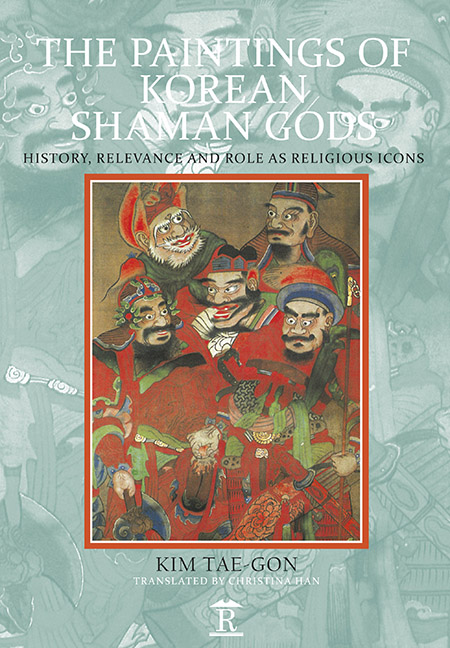Book contents
- Frontmatter
- Contents
- Translator’s Preface
- List of Figures
- List of Plates
- Introduction Visions, Images, Performance: Understanding Korean Shaman Art
- Chapter 1 Paintings Of Korean Shaman Gods
- Chapter 2 The Shaman God Painting As An Icon And Its Artistic Qualities
- Images Of Korean Shaman Gods
- Glossary of Terms
Translator’s Preface
Published online by Cambridge University Press: 30 April 2022
- Frontmatter
- Contents
- Translator’s Preface
- List of Figures
- List of Plates
- Introduction Visions, Images, Performance: Understanding Korean Shaman Art
- Chapter 1 Paintings Of Korean Shaman Gods
- Chapter 2 The Shaman God Painting As An Icon And Its Artistic Qualities
- Images Of Korean Shaman Gods
- Glossary of Terms
Summary
THIS IS AN ENGLISH translation of the Korean book Hanguk Musindo (Paintings of Korean Shaman Gods), a seminal work in the study of Korean shaman art published in 1989. The author Kim Tae-gon (1937–1996) was an ethnographer specializing in Korean shamanism. Throughout his professional life, Kim worked tirelessly as a professor and director of museums and research centres and served as the president of Korean Folklore Society. He authored many scholarly books on shamanism in Korea, China and Mongolia. In his chapter, “Reflections on Shaman God Paintings and Shamanism,” Kim presents the findings of his life-long research on the paintings of Korean shaman gods, namely, their history and distribution as well as their connection to shaman spirituality. During his research, Kim travelled extensively throughout South Korea to rediscover these sacred images that once played an important role in the religious life of Koreans. The paintings illustrated in this book show some of the works he located and studied.
Bak Yong-suk (b.1935) was a professor of art history at Dongduk Women's University and a prolific author in the field of Korean art history and religions. In her chapter, “The Shaman God Paintings as an Icon and Its Artistic Qualities,” Bak examines prehistorical evidence and historical records concerning the origins, functions, and symbolic significance of the paintings.
Thirty years have passed since the original publication of the book, but the information and images contained in it are still valuable and influential in the study of Korean art history and shamanism.
The book was instrumental in my own work and research as a Curatorial Consultant for the Korean Collection at the Royal Ontario Museum (ROM) in Canada. The ROM's collection includes a number of paintings of Korean shaman gods from the late nineteenth and early twentieth century. When I learned that the Literature Translation Institute of Korea was looking to produce an English translation of the book, I embraced the opportunity. My introductory chapter, “Visions, Images, Performance: Understanding Korean Shaman Art,” is based on a keynote address I delivered at the ROM's Bishop White Annual Lecture in 2007.
The publication of this book would not have been possible without the generous support from the Literature Translation Institute of Korea. I want to express special thanks to the original publisher Youlhwadang and to Paul Norbury at Renaissance Books.
- Type
- Chapter
- Information
- The Paintings of Korean Shaman GodsHistory, Relevance and Role as Religious Icons, pp. vii - viiiPublisher: Amsterdam University PressPrint publication year: 2018

